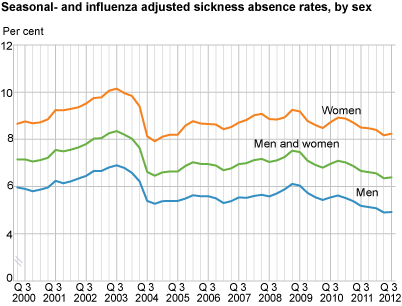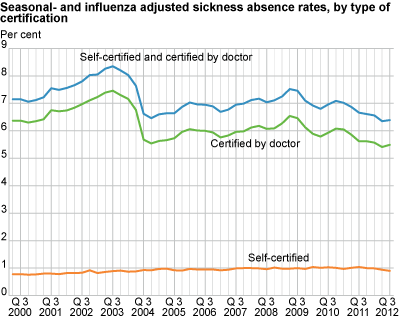Content
Published:
This is an archived release.
Increase in seasonally-adjusted sickness absence
Sickness absence adjusted for seasonal and influenza variations vas 6.4 per cent in the 3rd quarter of 2012 - an increase of 0.7 per cent from the 2nd quarter of 2012.
Doctor-certified sickness absence increased by 1.5 per cent and self-certified absence dropped 4.5 per cent.
Both men and women had a rise in the seasonal and influenza-adjusted sickness absence, of 0.5 and 0.8 per cent respectively.
Since the 2nd quarter of 2001, when the agreement on an inclusive labour market was implemented, the seasonal and influenza-adjusted sickness absence has dropped by 11.5 per cent.
Statistics without seasonal and influenza adjustment
Since the following comments in this article are based on data that is not adjusted for seasonal and influenza variations, we look at changes over the past year, from the 3rd quarter of 2011 to the 3rd quarter of 2012. During this period, the sickness absence rates decreased by 5 per cent.
The self-certified sickness absence rate decreased by 14.6 per cent and the doctor-certified rate dropped 3.6 per cent from the 3rd quarter of 2011 to the 3rd quarter of 2012.
Largest reduction among men
Sickness absence among men has fallen from 5.2 to 4.9 per cent in the last year - a decrease of 5.8 per cent. Sickness absence among women has declined from 8.4 per cent to 8 per cent. This corresponds to a decrease of 4.3 per cent.
Decrease in all industries - except one
The sickness absence rate decreased in all industries except one: agriculture, forestry and fishing had a small increase of 0.9 per cent. The information and communication industry and the transportation and storage industry had the largest decreases, of 12 and 10.4 per cent respectively.
Largest reduction in public administration
The sickness absence rate in all sectors went down last year. Public administration, including health enterprises, had the largest reduction with 7.9 per cent. Sickness absence in the private sector dropped 5.6 per cent, while decreasing 2 per cent in local government.
Decrease among the youngest age groups
The doctor-certified absence fell in all age groups below 64 years. The strongest reductions were within the age groups 20-24 and 30-34 years, by 5.7 and 4.6 per cent respectively.
Among men, the strongest declines were in the age groups 60-64 and 30-34 years, by 7.1 and 6.3 per cent respectively. Among women, the strongest reductions were in the age groups 20-24 and 35-39 years, by 6 and 3.9 per cent respectively.
These results are based on data on sickness absence certified by a doctor, as the survey on self-certified absence does not contain data on sickness absence by age.
Technical informationRates of change The sickness absence rates are presented using one decimal point. More decimal points are used when calculating the rates of change in order to get more accurate figures. These will therefore differ slightly from the rates of change produced when using the published rounded figures. The statistics do not cover self-employed persons. Seasonal and influenza -adjusted sickness absenceSickness absence adjusted for seasonal and influenza variations makes it easier to interpret variations from quarter to quarter, as distinct from the long-term trend. When new data is available, the seasonal and influenza-adjusted number for earlier quarters - especially the last quarter - may be revised. |
Tables
Sickness absence man-days for employees in per cent of scheduled man-days. Seasonal- and influenza adjusted
- Table 35 Sickness absence man-days for employees aged 16-69 in per cent of scheduled man-days, by type of certification. Seasonal- and influenza adjusted. Quarterly figures and change in per cent from previous quarter
- Table 36 Sickness absence man-days for employees aged 16-69 in per cent of scheduled man-days, by sex and type of certification. Seasonal- and influenza adjusted. Quarterly figures
- Table 37 Sickness absence man-days for employees aged 16-69 in per cent of scheduled man-days, by sex and type of certification. Seasonal- and influenza adjusted. Change in per cent from previous quarter
Sickness absence man-days for employees self-certified and certified by a doctor. In per cent of scheduled man-days (Sickness absence rate). Quarterly figures
- Table 1 Sickness absence man-days for employees self-certified and certified by a doctor. In per cent of scheduled man-days (Sickness absence rate). Quarterly figures. 2000-2012
- Table 2 Sickness absence man-days for employees self-certified and certified by a doctor, by sex. In per cent of scheduled man-days (Sickness absence rate). Quarterly figures. 2000-2012
- Table 28 Sickness absence by type of absence (self-certified or doctor-certified) and duration within the quarter
Contact
-
Arbeidsmarked og lønn
E-mail: arbeidsmarked@ssb.no
-
Unn H. Høydahl
E-mail: unnh.hoydahl@ssb.no
tel.: (+47) 40 90 23 77


